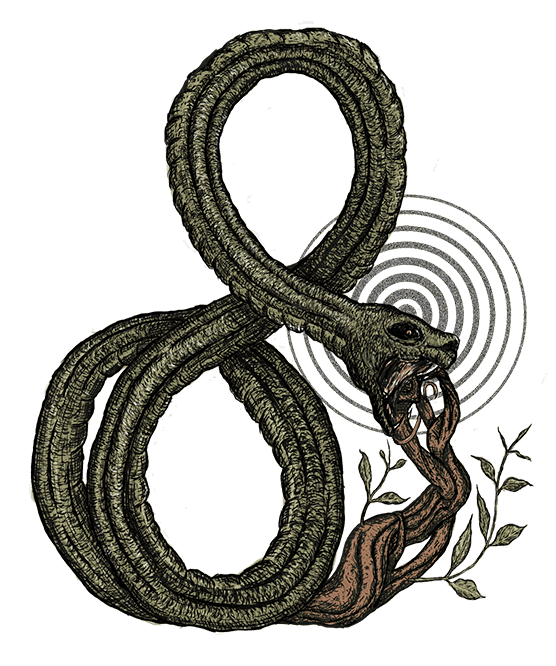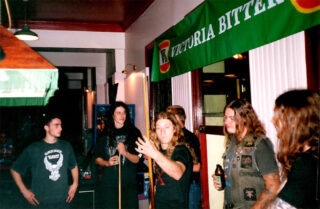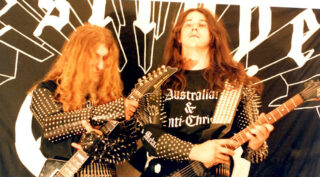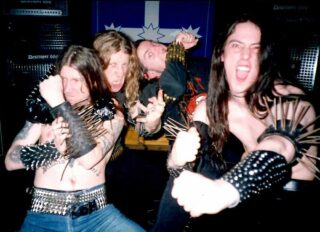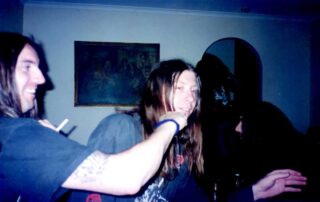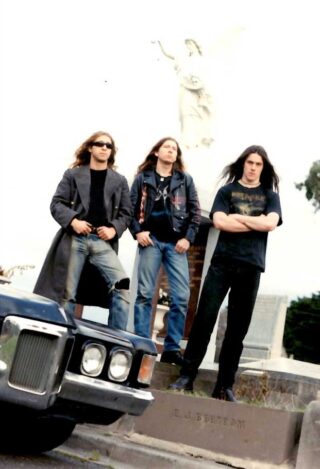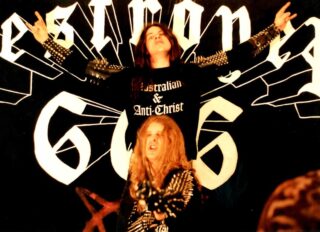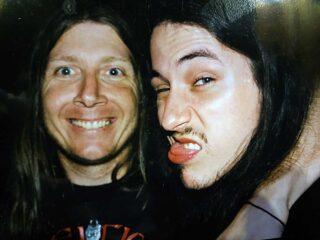Deströyer 666 I
2023-09-20
by Niklas Göransson
KK Warslut’s departure from Bestial Warlust set the stage for a new musical venture: Deströyer 666. Over the following two years, this unique fusion of musicians gave rise to a landmark album known as Unchain the Wolves.

KK WARSLUT: “Song for a Devil’s Son” and “The Eternal Glory of War” were originally written for BESTIAL WARLUST, but the others kept complaining about ’em. That’s when I thought, ‘You know what? Maybe they’re right; perhaps the purity of BESTIAL WARLUST should be maintained.’ I now believe it was to their credit that they rejected the songs, regardless of what my ego said then. Eventually, I conceded and said, ‘Alright, fair enough.’ I think that’s when I got the idea of doing my own thing – a side-project just to get the songs out there.
KK had been jamming with ex-VULGAR drummer Chris Volcano, and so decided to record the material with him. The DESTRÖYER 666 demo “Six Songs with the Devil” was released in September 1994.
WARSLUT: I came down with a stomach bug during the recording, so I was lying on the floor behind the mixing desk, just… ‘Ugh.’ They’d go, ‘What did you think of that, Keith?’ And I’m fucking dying down there: ‘Huh? Yeah, sounds good mate.’ Then I’d do one vocal take and ask, ‘Was that any good?’ ‘Yep, fine.’ ‘All right – next one.’ That’s why much of it sounds pretty bad. Nonetheless, I loved that demo. You know, it’s out of time and sloppy, but I didn’t care because there was something special about it.
Towards the end of 1994, KK left BESTIAL WARLUST. A few months later, while preparing to record the debut album of DESTRÖYER 666, he brought in Bullet Eater – also known as Fiend of the Deep in BESTIAL WARLUST and as Phil Gresik in HOBBS’ ANGEL OF DEATH – on bass guitar.
WARSLUT: I was aware of Phil from HOBBS’, of course, and then we met through the BESTIAL boys. We hit it off really well, so I roped him into playing bass for me. Phil and I went around to Chris Volcano’s mum’s garage to rehearse, and once we’d gone through one run of the songs, Chris said, ‘Okay, we’re done here’, and just stood up to leave. Phil was stunned. ‘You’re kidding me, right? We’re about to record an album, and that’s it? One fucking rehearsal?’ So, we went through them once more and then did two additional rehearsals. Chris had lost interest for some reason – he’d also started ABOMINATOR by then, which might’ve had something to do with it.
ABOMINATOR – a black/death duo consisting of Chris Volcano and Andrew Undertaker – recorded a demo called “Barbarian War Worship” in May 1995. The same month, DESTRÖYER 666 started tracking “Violence is the Prince of This World”. Besides the two songs spurned by BESTIAL WARLUST, KK dusted off “Burning the Veil of Falsehood” – a track he wrote for the band’s predecessor, CORPSE MOLESTATION, back in 1991.
WARSLUT: My deal with Chris was that I’d promised him a bunch of drum equipment in exchange for the recording. I said, ‘I’ll buy you a double-kick pedal and…’ hmm, a couple of cymbals, I think? It was worth eight hundred bucks or something, which – at our age and in that situation – was pretty fucking good payment. But when we got to the studio, Chris wasn’t any better than in rehearsal; just completely uninterested, ‘Let’s get it over and done with as fast as possible.’ Essentially, it never should’ve happened. I was an atrocious guitar player, and Chris was a disinterested drummer.
When all was said and done, two of the songs were so poorly performed that KK refused to release them. However, soon after the studio visit, he met local drummer Matt Skitz, who agreed to help DESTRÖYER 666 re-record the tracks.
WARSLUT: Skitz was phenomenal; I’d never worked with a drummer like that before. He insisted on playing those two songs over and over; we spent hours in rehearsal until the point where I went, ‘Okay, enough. How good can it be, mate?’ But he goes, ‘No, one more time.’ That was the first time I encountered that strong urge for perfection, which is a strange thing to have an urge for when you’re dealing with me.
Matt Skitz had recently returned from his stint as session drummer for SADISTIK EXEKUTION on their notorious European tour with IMPALED NAZARENE and ABSU. He was also in a Melbourne band called DAMAGED.
WARSLUT: DAMAGED sounded like an extreme form of PANTERA. They were huge in Australia, fucking massive, and would easily get five hundred people to a gig. Matt Skitz had taken to sitting backwards on stage so the audience could see his kick drums going crazy. I wasn’t a fan of the band, but – to be perfectly honest – they were very talented. Even though the singer had some mental issues, which fuelled a longstanding animosity towards me; one that he kept up for like ten fucking years after I left Australia! All very silly.
What was that about?
WARSLUT: I think the whole thing started when DAMAGED did a BATHORY cover. I happened to walk in on one of their mega-gigs with six hundred people or so, and they were doing “Equimanthorn”. I almost had tears in my eyes I was so upset. It seemed to me like blaspheming the song, taking it to all these fuckers who didn’t know BATHORY. You know, people with dreadlocks and fucking… uh, it’s a testimony to how emotional I was and, in part, of my stupidity. I let my feelings be known to some of the members, and I reckon that – and some other things – is what sparked the feud.
In November 1995, “Violence Is the Prince of This World” was released by Modern Invasion, the same Melbourne label that had signed BESTIAL WARLUST three years earlier. Around the same time, Mark ‘Coz’ Howitzer – a drummer who grew up with KK in the South Australian town of Whyalla – moved from Brisbane to Melbourne. They had previously played together in a short-lived project called DEATHFUCK. A few months earlier, Howitzer recorded the classic “The Satanist’s Dream” demo with his own band, GOSPEL OF THE HORNS.
MARK HOWITZER: I’d been a fan of DESTRÖYER ever since I heard “Six Songs with the Devil”. That demo was unreal – the vocals sounded great, and the music had a sort of old-school black thrash vibe. I moved to Melbourne just as “Violence…” came out. Keith (KK) was always big on vinyl, and I remember how excited he was when the LPs arrived. He had four or five copies to give his best mates from Whyalla, like Richie (MEPHISTOPHELES), Andros, and Rob (VOMITOR).
At the time, KK was still writing music but had no plans to turn DESTRÖYER 666 into an active band. The following month, on Christmas Day, KK got together with a session drummer – Shane Rout from ABYSSIC HATE – to try out some ideas.
WARSLUT: It was terrible. Nothing worked; we didn’t gel at all. Afterwards, I went to drop him off back home and ended up coming in for a smoke and a drink. He goes, ‘Maybe we should just jam here with a drum machine, and I can record it?’ I was like, ‘Eh, okay.’ And that went really well straight off the bat. Every riff I played, Routy would have great ideas for. “Genesis to Genocide”, for instance, I’d originally envisioned it with blastbeats – but he went, ‘What about this?’ <hums beat> ‘Yeah, that’s much better.’ I thought, ‘Fuck, this is why I need a drummer.’
HOWITZER: Keith played me a demo version of “Genesis…” – I remember it vividly. It had a drum machine, but you could get an idea about where the material was going. I started pushing him, ‘This is great; we should really look at turning DESTRÖYER into a proper band.’ I remember rehearsing that song back when it was just Keith and me. I think we’d also started working on the other slow track, “Tyranny of the Inevitable”. We had a hard time finding a guitarist, though. We actually did a rehearsal with Phil on guitar, but that didn’t work out. However, it wasn’t long after that we found Ian Shrapnel.
WARSLUT: Ian was going out with the best mate of my ex-girlfriend, whom I was still friends with. I mentioned being on the lookout for a guitar player, and she goes, ‘Oh, Ian plays.’ ‘What? That skater guy?’ and she says, ‘No, no, he’s been listening to metal for years.’ I went, ‘Yeah? What kind of metal?’ ‘SLAYER.’ ‘Really? SLAYER?’ ‘Yeah, and he can do solos and stuff.’ I thought, ‘Fuck, this sounds promising.’ I went around to his place, and there he was. I remember that he played solos like I thought I would if I could play solos. And he was keen to join a band – so, done deal.
IAN SHRAPNEL: I’d never been in a formal band before but did have some jamming experience. Keith mentioned that his drummer mate had recently come down from Brisbane. I recall meeting Coz at Keith’s place… at first, it wasn’t exactly ‘Oh, this is gonna be a band!’ Rather, ‘Alright, let’s see what happens.’ But bear in mind that this is going back a while, so it’s all a bit foggy.
HOWITZER: Ian was pretty quiet and shy at first. Good bloke – he was just really laid back. Which, as you know, is probably the best way to be if you’re gonna work with Keith. Ian looked exactly the same as he did ten years later but was a bit more innocent, you could say.
This line-up – KK Warslut, Bullet Eater, Mark Howitzer, and Ian Shrapnel – created the classic DESTRÖYER 666 sound, as heard on their second album, “Unchain the Wolves”. It is perhaps best described as a violent and atmospheric mix of old German thrash and 90s black metal.
WARSLUT: To put it bluntly, I wasn’t good enough to just pick a style, attain mastery over it, and then merge that with something else. I bloody wish, but that was never the case. I tend to play what I can play, and it just comes out. I wish there were some mystery and more fucking books to be written on the topic, but it’s really very simple.
SHRAPNEL: Songwriting is like pushing a snowball down the hill; it sort of picks up and picks up until, eventually, it’s outta control and can end up anywhere. But nothing felt forced – it was all natural. There was a vibe in the rehearsal room; you could tell things were happening. We used to headbang and… it just had this energy, you know?
The first two songs they wrote for the album, “Genesis to Genocide” and “Tyranny of the Inevitable”, share roughly the same blueprint. In terms of pacing and feel, it sounds as if KK built further upon what he did with “The Eternal Glory of War”. Slow and atmospheric beginnings transition into basic structures with mid-tempo aggression and melodic passages, which build up to a breakdown to then climax in a grand finale.
HOWITZER: We were trying to create a formula of sorts. We wanted them to start off slow and powerful, build up, go down again, and then end with a crescendo – like the one towards the end of “Genesis…”.
WARSLUT: I loved epic endings, and I still do. I often start writing a song at the end. Not deliberately, I just write something and think, ‘Fuck, this is great – but it’s definitely a closing bit. You can’t start the song with something like this.’ Because then the ending would have to be so epic that you’d need to be fucking Chopin or Beethoven.
The third song they finished, “Damnation’s Pride”, is more of a straightforward ripper – starkly contrasting the aforementioned two epics.
HOWITZER: I remember Keith saying that he wanted three more songs with a thrashy sort of old-school sound. He told Ian and me, ‘You guys can write one each, and I’ll put in another one.’ So, he was really good like that. I brought “Australian and Antichrist”, which was basically an old GOSPEL OF THE HORNS song we’d never recorded. Keith came up with “Six Curses from a Spiritual Wasteland” – and once Ian threw in “Satan’s Hammer”, everything just started moulding together.
SHRAPNEL: I didn’t have the experience the other guys had, and I was very much aware of what a privileged position I was in. Especially jamming with the likes of Phil. ‘Fuck me, that’s the guy from HOBBS’!’ On the back cover of “Hobbs’ Angel of Death” – there’s Phil. And now he was in the room with us, playing bass and shit, you know? He had such great ideas too. And then Keith and Coz, they had the attitude.
WARSLUT: Phil was great to have in the band; very helpful for songwriting and as a grounding force. He was always super-enthusiastic as well. Like, I’m writing simple riffs, but he’d tolerate them and help me come up with chords and stuff to make ‘em sound more interesting. “Genesis to Genocide”, for instance: the main riff is just a basic repeat drone, but Phil keeps moving all around on the bass, which spiced the riff up to no end.
HOWITZER: Phil was invaluable – partly because of his experience, but he also has a great ear for these things. Originally, “…Antichrist” had a bridge where the bass comes in and does slides and stuff. There used to be another section of the song with a couple of riffs that Keith wrote. We kept humming and hawing: ‘Should we keep it or not?’ And then Phil came to rehearsal and said, ‘Look, guys, why don’t you just cut out all the shit in the middle? It’s not needed. Just keep it a simple thrasher.’ And that’s what we did.
The title track of “Unchain the Wolves” covers the album’s entire musical spectrum – it has not only the slow-paced grandeur of “Genesis…” and “Tyranny…” but also the testosterone-filled anthemic quality of “Australian and Antichrist”. And no less than four guitar solos.
HOWITZER: From memory, “Unchain…” was the last song we wrote. I reckon that’s the one Keith put the most effort into. He sat at home a lot, thinking, ‘Okay, what else could it do? Where does the song go from here?’ You know, his mind is always ticking. For me, that’s the highlight of the album. And the lyrics are up there with the best he’s done – just like a fist to the face. Especially paired with Keith’s distinctive vocals; the way he pronounced the lyrics meant you could follow along with and understand them. We arranged the song at rehearsal, and it came together incredibly well.
SHRAPNEL: When the vibe is inspired, you can enter this flow state where you’re playing but not actively thinking, ‘Oh, now I’m gonna go to this.’ If you avoid being stiff and rigid and instead ease into the music and let the ideas come to you, that’s when the magic happens. It just comes out. Having a solid connection within the band is also important – like looking everyone in the eyes while you’re jamming together. We had great chemistry, but we weren’t good players. That didn’t matter, though; we could just lock into this feeling, which was the main thing.
WARSLUT: I always put it down to this equation: a pinch of talent and a pound of passion. Phil was an experienced player with a good musical ear, Coz was a great drummer in the spirit of Clive Burr (IRON MAIDEN), and Ian kept ripping out the kind of solos I wanted to play. Yeah, it was a golden fucking line-up for us.
HOWITZER: In mid-96, we demoed the songs; Daniel from Modern Invasion, who was always a big fan of Keith’s work, was hanging to hear ‘em. I remember it well because I was sick – crook as a dog. I found out a day or two later that I had tonsillitis. It was hideous, and my playing was extremely sloppy. I recall leaning back against the wall playing, and the guys were stirring me up and giving me shit. But we did the whole thing in one day, and when Daniel heard it, he really got behind us and wanted promo shots and everything else. Four months or so later, we entered the studio.
log in to keep reading
The second half of this article is reserved for subscribers of the Bardo Methodology online archive. To keep reading, sign up or log in below.
